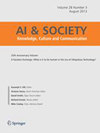期刊簡介
Journal Title:Ai & Society
ai & Society: Knowledge, Culture And Communication, Is An International Journal Publishing Refereed Scholarly Articles, Position Papers, Debates, Short Communications, And Reviews Of Books And Other Publications. Established In 1987, The Journal Focuses On Societal Issues Including The Design, Use, Management, And Policy Of Information, Communications And New Media Technologies, With A Particular Emphasis On Cultural, Social, Cognitive, Economic, Ethical, And Philosophical Implications.
ai & Society Has A Broad Scope And Is Strongly Interdisciplinary. We Welcome Contributions And Participation From Researchers And Practitioners In A Variety Of Fields Including Information Technologies, Humanities, Social Sciences, Arts And Sciences. This Includes Broader Societal And Cultural Impacts, For Example On Governance, Security, Sustainability, Identity, Inclusion, Working Life, Corporate And Community Welfare, And Well-being Of People. Co-authored Articles From Diverse Disciplines Are Encouraged.
ai & Society Seeks To Promote An Understanding Of The Potential, Transformative Impacts And Critical Consequences Of Pervasive Technology For Societies. Technological Innovations, Including New Sciences Such As Biotech, Nanotech And Neuroscience, Offer A Great Potential For Societies, But Also Pose Existential Risk. Rooted In The Human-centred Tradition Of Science And Technology, The Journal Acts As A Catalyst, Promoter And Facilitator Of Engagement With Diversity Of Voices And Over-the-horizon Issues Of Arts, Science, Technology And Society.
ai & Society Expects That, In Keeping With The Ethos Of The Journal, Submissions Should Provide A Substantial And Explicit Argument On The Societal Dimension Of Research, Particularly The Benefits, Impacts And Implications For Society. This May Include Factors Such As Trust, Biases, Privacy, Reliability, Responsibility, And Competence Of Ai Systems. Such Arguments Should Be Validated By Critical Comment On Current Research In This Area. Curmudgeon Corner Will Retain Its Opinionated Ethos.
the Journal Is In Three Parts: A) Full Length Scholarly Articles; B) Strategic Ideas, Critical Reviews And Reflections; C) Student Forum Is For Emerging Researchers And New Voices To Communicate Their Ongoing Research To The Wider Academic Community, Mentored By The Journal Advisory Board; Book Reviews And News; Curmudgeon Corner For The Opinionated.
papers In The Original Section May Include Original Papers, Which Are Underpinned By Theoretical, Methodological, Conceptual Or Philosophical Foundations. The Open Forum Section May Include Strategic Ideas, Critical Reviews And Potential Implications For Society Of Current Research. Network Research Section Papers Make Substantial Contributions To Theoretical And Methodological Foundations Within Societal Domains. These Will Be Multi-authored Papers That Include A Summary Of The Contribution Of Each Author To The Paper. Original, Open Forum And Network Papers Are Peer Reviewed. The Student Forum Section May Include Theoretical, Methodological, And Application Orientations Of Ongoing Research Including Case Studies, As Well As, Contextual Action Research Experiences. Papers In This Section Are Normally Single-authored And Are Also Formally Reviewed. Curmudgeon Corner Is A Short Opinionated Column On Trends In Technology, Arts, Science And Society, Commenting Emphatically On Issues Of Concern To The Research Community And Wider Society. Normal Word Length: Original And Network Articles 10k, Open Forum 8k, Student Forum 6k, Curmudgeon 1k. The Exception To The Co-author Limit Of Original And Open Forum (4), Network (10), Student (3) And Curmudgeon (2) Articles Will Be Considered For Their Special Contributions.
please Do Not Send Your Submissions By Email But Use The "submit Manuscript" Button.
note To Authors: The Journal Expects Its Authors To Include, In Their Submissions:
a) An Acknowledgement Of The Pre-accept/pre-publication Versions Of Their Manuscripts On Non-commercial And Academic Sites.
b) Images: Obtain Permissions From The Copyright Holder/original Sources.
c) Formal Permission From Their Ethics Committees When Conducting Studies With People.
中文簡介
《人工智能與社會:知識、文化與交流》是一本國際期刊,發表經過評審的學術文章、立場文件、辯論、簡短通訊以及書籍和其他出版物的評論。該期刊成立于 1987 年,專注于社會問題,包括信息、通信和新媒體技術的設計、使用、管理和政策,特別強調文化、社會、認知、經濟、倫理和哲學影響。
《人工智能與社會》范圍廣泛,跨學科性強。我們歡迎來自信息技術、人文科學、社會科學、藝術和科學等各個領域的研究人員和從業人員的貢獻和參與。這包括更廣泛的社會和文化影響,例如對治理、安全、可持續性、身份、包容性、工作生活、企業和社區福利以及人民福祉的影響。鼓勵來自不同學科的共同撰寫文章。
《人工智能與社會》旨在促進對普及技術對社會的潛在、變革性影響和關鍵后果的理解。技術創新,包括生物技術、納米技術和神經科學等新科學,為社會提供了巨大的潛力,但也帶來了生存風險。該期刊植根于以人為本的科學技術傳統,充當著催化劑、推動者和促進者的角色,以參與藝術、科學、技術和社會的多元化聲音和未來問題。
《人工智能與社會》希望,為了符合期刊的精神,投稿應就研究的社會維度提供實質性和明確的論據,特別是對社會的益處、影響和含義。這可能包括信任、偏見、隱私、可靠性、責任和人工智能系統的能力等因素。這些論點應該通過對該領域當前研究的批判性評論來驗證。Curmudgeon Corner 將保留其固執己見的精神。
該期刊分為三個部分:A)全文學術文章;B)戰略思想、批判性評論和反思;C)學生論壇,供新興研究人員和新聲音在期刊顧問委員會的指導下向更廣泛的學術界傳達他們正在進行的研究;書評和新聞;Curmudgeon Corner 供固執己見者使用。
原創部分的論文可能包括以理論、方法、概念或哲學基礎為基礎的原創論文。開放論壇部分可能包括戰略思想、批判性評論和當前研究對社會的潛在影響。網絡研究部分論文對社會領域的理論和方法基礎做出了重大貢獻。這些論文將是多作者論文,其中包括每位作者對論文的貢獻摘要。原創、開放論壇和網絡論文經過同行評審。學生論壇部分可能包括正在進行的研究的理論、方法和應用方向,包括案例研究以及情境行動研究經驗。本部分的論文通常由一位作者撰寫,也經過正式審查。Curmudgeon Corner 是一個關于技術、藝術、科學和社會趨勢的簡短觀點專欄,重點評論研究界和整個社會關注的問題。正常字數:原創和網絡文章 10k,開放論壇 8k,學生論壇 6k,Curmudgeon 1k。原創和公開論壇 (4)、網絡 (10)、學生 (3) 和 Curmudgeon (2) 文章的共同作者限制例外情況將因其特殊貢獻而予以考慮。
請不要通過電子郵件發送您的投稿,而是使用“提交手稿”按鈕。
作者須知:期刊希望作者在其投稿中包括:
a) 在非商業和學術網站上對其手稿的預接受/預出版版本的確認。
b) 圖像:從版權持有者/原始來源處獲得許可。
c) 與人進行研究時,需要獲得其倫理委員會的正式許可。
期刊點評
Ai & Society由Springer Nature出版商出版,收稿方向涵蓋COMPUTER SCIENCE, ARTIFICIAL INTELLIGENCE全領域,平均審稿速度 ,影響因子指數2.9,該期刊近期沒有被列入國際期刊預警名單,廣大學者值得一試。
WOS分區(數據版本:2023-2024年最新版)
| 按JIF指標學科分區 | 收錄子集 | 分區 | 排名 | 百分位 |
| 學科:COMPUTER SCIENCE, ARTIFICIAL INTELLIGENCE | ESCI | Q2 | 95 / 197 |
52% |
| 按JCI指標學科分區 | 收錄子集 | 分區 | 排名 | 百分位 |
| 學科:COMPUTER SCIENCE, ARTIFICIAL INTELLIGENCE | ESCI | Q3 | 122 / 198 |
38.64% |
名詞解釋:
WOS即Web of Science,是全球獲取學術信息的重要數據庫,Web of Science包括自然科學、社會科學、藝術與人文領域的信息,來自全世界近9,000種最負盛名的高影響力研究期刊及12,000多種學術會議多學科內容。給期刊分區時會按照某一個學科領域劃分,根據這一學科所有按照影響因子數值降序排名,然后平均分成4等份,期刊影響因子值高的就會在高分區中,最后的劃分結果分別是Q1,Q2,Q3,Q4,Q1代表質量最高。
CiteScore分區(數據版本:2024年最新版)
| CiteScore | SJR | SNIP | CiteScore排名 | ||||||||||||||||
| 8 | 0.976 | 1.939 |
|
名詞解釋:
CiteScore:衡量期刊所發表文獻的平均受引用次數。
SJR:SCImago 期刊等級衡量經過加權后的期刊受引用次數。引用次數的加權值由施引期刊的學科領域和聲望 (SJR) 決定。
SNIP:每篇文章中來源出版物的標準化影響將實際受引用情況對照期刊所屬學科領域中預期的受引用情況進行衡量。
其他數據
| 是否OA開放訪問: | h-index: | 年文章數: |
| 未開放 | - | 147 |
| Gold OA文章占比: | 2021-2022最新影響因子(數據來源于搜索引擎): | 開源占比(OA被引用占比): |
| 51.42% | 2.9 | |
| 研究類文章占比:文章 ÷(文章 + 綜述) | 期刊收錄: | 中科院《國際期刊預警名單(試行)》名單: |
| 99.32% | SCIE | 否 |
歷年IF值(影響因子):
歷年引文指標和發文量:
歷年自引數據:
更多問題
免責聲明
若用戶需要出版服務,請聯系出版商。
